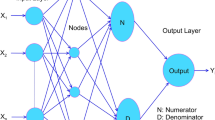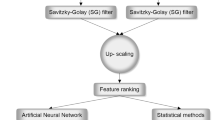Abstract
Accurate prediction of ore grade is essential for many basic mine operations, including mine planning and design, pit optimization, and ore grade control. Preference is given to the neural network over other interpolation techniques for ore grade estimation because of its ability to learn any linear or non-linear relationship between inputs and outputs. In many cases, ensembles of neural networks have been shown, both theoretically and empirically, to outperform a single network. The performance of an ensemble model largely depends on the accuracy and diversity of member networks. In this study, techniques of a genetic algorithm (GA) and k-means clustering are used for the ensemble neural network modeling of a lead–zinc deposit. Two types of ensemble neural network modeling are investigated, a resampling-based neural ensemble and a parameter-based neural ensemble. The k-means clustering is used for selecting diversified ensemble members. The GA is used for improving accuracy by calculating ensemble weights. Results are compared with average ensemble, weighted ensemble, best individual networks, and ordinary kriging models. It is observed that the developed method works fairly well for predicting zinc grades, but shows no significant improvement in predicting lead grades. It is also observed that, while a resampling-based neural ensemble model performs better than the parameter-based neural ensemble model for predicting lead grades, the parameter-based ensemble model performs better for predicting zinc grades.
Similar content being viewed by others
References
Bishop CM (1998) Neural networks for pattern recognition. Oxford University Press, New York
Breiman L (1996) Bagging predictors. Mach Learn 24(2):123–140
Chao L (2004) Multidimensional nonstationary maximum entropy spectral analysis by using neural net. Math Geol 31(6):685–700
Chatterjee S, Bhattacherjee A, Samanta B, Pal SK (2006) Ore grade estimation of a limestone deposit in India using an artificial neural network. Appl GIS 2(1):2.1–2.20
Cho S-B, Ahn J-H (2001) Speciated neural networks evolved with fitness sharing technique. Congr Evol Comput 1:390–396
David RL, Gregory JM (1999) Evaluating the use of “goodness-of-fit” measures in hydrological and hydro-climatic model validation. Water Resour Res 35(1):233–241
Devijver PA, Kittler J (1982) Pattern recognition: a statistical approach. Prentice Hall, Englewood Cliffs
Dietterich TG (1998) Machine-learning research: four current directions. AI Mag 18(4):97–136
Dondeti S, Kannan K, Manavalan R (2005) Genetic algorithm optimized neural networks ensemble for estimation of mefenamic acid and paracetamol in tablets. Acta Chim Slov 52:440–449
Dowd PA, Sarac C (1994) A neural network approach to geostatistical simulation. Math Geol 26:491–503
Dutta S, Misra D, Ganguli R, Bandopadhyay S (2006) A hybrid ensemble model of kriging and neural network for ore grade estimation. Int J Surf Min Reclam Environ 20(1):33–45
Girosi F (1998) An equivalence between sparse approximation and support sector machines. Neural Comput 10:1455–1480
Goldberg DE (2002) Genetic algorithms in search, optimization, and machine learning. Pearson Education Asia, Delhi
Haykins S (1999) Neural networks: a comprehensive foundation, 2nd edn. Prentice Hall, New Jersey
Koike K, Matsuda S, Gu B (2001) Evaluation of interpolation accuracy of neural kriging with application to temperature-distribution analysis. Math Geol 28:421–448
Koike K, Matsuda S, Suzuki T, Ohmi M (2002) Neural network-based estimation of principal metal contents in the Hokuroku district, northern Japan, for exploring Kuroko-type deposits. Nat Resour Res 11(2):135–156
Krogh A, Vedelsby J (1995) Neural network ensembles, cross-validation, and active learning. Neural Inf Process Syst 7:231–238
Li K, Huang H-K, Ye X-C, Chi L-J (2004) A selective approach to neural network ensemble based on clustering technology. In 3rd international conference on machine learning and cybernetics, 26–29th August, 2004. Shanghai, China, pp 3229–3233
Liu Y, Yao X (1997) Evolving modular neural networks which generalize well. In IEEE international conference on evolutionary computation, Indianapolis, USA, pp 605–610
Liu Y, Yao X (1999) Ensemble learning via negative correlation. Neural Netw 12:1399–1404
Liu Y, Yao X, Higuchi T (2000) Evolutionary ensembles with negative correlation learning. IEEE Trans Evol Comput 4(4):380–387
Matías J, Vaamonde A, Taboada J, González-Manteiga W (2004) Comparison of kriging and neural networks with application to the exploitation of a slate mine. Math Geol 36(4):463–486
Opitz DW, Shavlik JW (1996) Actively searching for an effective neural network ensemble. Connect Sci 8(3–4):337–353
Pan G, Gaard D, Moss K, Heiner T (1993) A comparison between co-kriging and ordinary kriging: case study with a polymetallic deposit. Math Geol 25(3):377–398
Rosen BE (1996) Ensemble learning using de-correlated neural networks. Connect Sci 8(3–4):373–384. Special issue on combining artificial neural: ensemble approaches
Samanta B, Bandopadhyay S, Ganguli R (2004a) Data segmentation and genetic algorithms for sparse data division in Nome placer grade estimation using neural network and geostatistics. Explor Min Geol 11:69–76
Samanta B, Bandopadhyay S, Ganguli R, Dutta S (2004b) Sparse data division using data segmentation and Kohonen network for neural network and geostatistical ore grade modeling in Nome offshore placer deposit. Nat Resour Res 13(3):189–200
Samanta B, Bandopadhyay S, Ganguli R (2006) Comparative evaluation of neural network learning algorithms for ore grade estimation. Math Geology 38(2):175–197
Schapire RE (1990) The strength of weak learnability. Mach Learn 5(2):197–227
Sharkey A (1998) Combining artificial neural nets ensemble and modular multi-net systems. Springer, New York
Soler P, Bonhomme MG (1998) Oligocene magmatic activity and associated mineralization in the polymetallic belt of central Peru. Econ Geol 83:657–663
Vapnik V (1995) The nature of statistical learning theory. Springer, New York
Wu J-X, Zhou Z-H, Chen Z-Q (2001) Ensemble of GA based selective neural network ensembles. In 8th international conference on neural information processing, vol 3, pp 1477–1482
Yama BR, Lineberry GT (1999) Artificial neural network application for a predictive task in mining. Min Eng 51(2):59–64
Yamamoto JK (2004) An alternative measure of the reliability of ordinary kriging estimates. Math Geol 32(4):489–509
Author information
Authors and Affiliations
Corresponding author
Rights and permissions
About this article
Cite this article
Chatterjee, S., Bandopadhyay, S. & Machuca, D. Ore Grade Prediction Using a Genetic Algorithm and Clustering Based Ensemble Neural Network Model. Math Geosci 42, 309–326 (2010). https://doi.org/10.1007/s11004-010-9264-y
Received:
Accepted:
Published:
Issue Date:
DOI: https://doi.org/10.1007/s11004-010-9264-y




